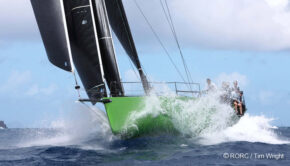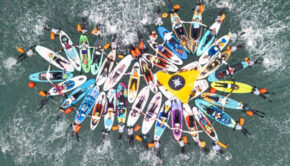Addressing the Issues of Para-Sailing
Published on April 18th, 2017
Scott Perry and Betsy Alison are two of the many people working tirelessly to ensure sailing’s early return to the Paralympic arena. In the May 2017 issue of Seahorse magazine, Perry and Alison provide this update.
In November 2014, World Sailing merged with the International Federation for Disabled Sailing (IFDS) to create a strong, sustainable organisational relationship to provide a solid platform to support sailing opportunities for people with disabilities.
But less than three months later the competitive sailing community received a stunning blow. The International Paralympic Committee (IPC) announced that sailing would not be included in the Tokyo 2020 Paralympic Games.
As with most setbacks, our first reaction was anger and frustration. Upon further reflection at World Sailing, we realised that, although the decision taken by the IPC was unquestionably a great disappointment, it provided us with a unique opportunity to carefully examine para-sailing as a whole; to address the problems that the IPC, quite rightly, faulted us on; and to make the necessary changes to get sailing back into the Paralympic Games.
Our challenge is to make para-sailing more accessible, more widely practised and more attractive from both the sailor’s and spectator’s standpoint. We are therefore addressing each one of the following three areas…
More accessible
The cost of equipment is always an issue in our sport. This is even more critical in para-sailing since, in many cases, the boats must be adapted to the unique needs of each para-sailor. Adaptations that can accommodate specific disability issues add to the overall cost of equipment.
We are looking carefully at the cost and adaptability of five types of boats, three of which have been used as Paralympic Games equipment (the 2.4mR Norlin OD, SKUD 18 and Sonar) and two ‘new’ boats (the Weta trimaran and Hansa 303). After careful evaluation of all five boats, we will select two or three as the Paralympic equipment.
Increased access to attend para-sailing events at a reasonable distance from one’s home is also critical to the growth and development of sailing worldwide for sailors with a disability. The cost of travel both for para-sailors and their boats is being addressed through the creation and use of regional qualification events not only to qualify for World Sailing events but to qualify countries for future Paralympic Games (once we get back into them).
More widely practised
After the IPC announcement in early 2015, the board of World Sailing took immediate action and approved an ambitious programme to attract more potential sailors to para-sailing, particularly in the less traditional sailing countries.
In the two years since its approval by the board of World Sailing, the Paralympic Development Program (PDP) has been up and running in five countries (UK, Australia, Netherlands, Argentina, and Hong Kong-Asia) with another two countries scheduled to join during 2017 (Poland and France). Over 35 potential para-sailors and approximately 25 coaches have participated in these programmes so far.
In 2017 we have already held programmes in Argentina and Hong Kong, with two more planned to specifically target sailors in eastern Europe and North Africa.
The results can already be seen in the increased number of countries represented at various para-sailing events. The PDP clinics are a vital part of World Sailing’s strategy to boost global participation in the sport and regain its Paralympic Games status.
An attractive competition
We are addressing this particular challenge by looking very closely at the racing format at our events. Several changes have been proposed but they will need extensive testing before they are adopted. Any changes to be made must be appealing to both sailors and spectators.
Shorter races, in an easily understood format, near to the shore for spectating, are central to the plan. Close racing, exciting and informed commentary, easily identifiable athletes and countries on the racecourse… these are all key elements to successful showcasing of para-sailing, both for live viewing and through media outlets.
World Sailing is fully committed to and looks forward to bringing para-sailing forward to the wider public in a way that allows everyone to enjoy the excitement of the sport of sailing as practised by an amazing group of athletes.
Editor’s note: There is an urgency for 32 nations to be represented at the 2017 Para World Sailing Championships on June 20-25. If participation falls below that, the return of Sailing at the 2024 Paralympic Games becomes unlikely.
Authors: Scott Perry is Vice-President and Treasurer at World Sailing and Betsy Alison is chair of the Para World Sailing Committee.
Seahorse is the dominant international magazine for anyone serious about their racing. Take advantage of their subscription offer or order a single copy of Seahorse online at www.seahorse.co.uk/shop or for iPad download the Seahorse App at the iTunes store. Contact by email at subscriptions@seahorse.co.uk.








 We’ll keep your information safe.
We’ll keep your information safe.